|
Current Issue - Spring/Summer 2013 Show Back Issues |
| ||
Collier Arbor Care Honored for RecyclingClackamas’ Collier Arbor Care has been recognized by Clackamas County with a Distinguished Business Recycling Awards Group (BRAG) membership certificate and recycled glass plaque from the Clackamas County Recycle at Work Program. 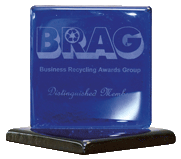 The distinguished BRAG award
The distinguished BRAG award
Distinguished BRAG memberships go to high-achieving Clackamas County area businesses that recycle all curbside materials regularly, prevent waste with at least six ongoing activities, consistently buy recycled paper and other recycled products and demonstrate a commitment to continuous improvement. Collier Arbor Care has gone well beyond recycling curbside materials, and it works with local suppliers to purchase recycled-content office supplies. It also recycles all tree and shrub debris and reuses packaging materials. Recently, the company replaced its sales staff trucks with Volkswagens powered by biodiesel, which helps the firm reduce its carbon footprint. In addition, all chemical containers are triple-rinsed and Collier employees are working with a local agricultural recycler to recycle the containers along with empty fertilizer bags, shrink wrap, and other sheet film from packaging. “This firm really stands out in its willingness to go the extra mile in recycling both at the office and out in the field.. Collier came to me to find out if there was more they could do,” said Waste Reduction Specialist Shannon Martin of Clackamas County’s Office of Sustainability. “This is something we have felt really strongly about for the last 20 years,” said Collier President Terrill Collier. “Since we’re in the ‘green’ business, we need to be a leader in sustainability.” Martin pointed out that the firm has been a leader in organic-based plant and tree care and that reducing its office waste stream is “another nice twist in that it also helps save trees, the thing they care most about because of the nature of their business.” Featured Tree: Eastern Redbud (Cercis canadensis)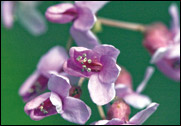 Blooms of the Eastern Redbud
Blooms of the Eastern Redbud
Redbud is a lovely small tree that is valued for its rosy to purple blossoms that appear in the early spring before the leaves. The blooms are pea shaped and appear in profusion on bare twigs and branches in March here in the Pacific Northwest. The most common species in our area is the eastern redbud native to eastern U.S. It grows to 20 to 30 feet tall and wide in a round headed spreading form. The attractive rounded heart shaped leaves turn a beautiful yellow color in the fall. 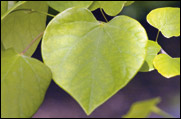 Foliage of the Eastern Redbud
Foliage of the Eastern Redbud
Redbuds grow in sun and partial shade in deep moist loamy soils. They
need summer water but will not tolerate wet conditions nor will they stand
drought. Redbuds are susceptible to Verticillium wilt so don’t plant
them in areas where a maple has died of that disease. Attractive graceful small tree, redbuds are effective when planted as a single specimen or are especially nice in woodland or naturalized settings. Several good cultivars exist such as ‘alba’ a white flowered form. ‘Forest pansy’ is a handsome purple leaf type, a perfect alternative to the common (and overplanted) flowering plum. The foliage emerges as a shimmering red-purple then changing to a more subdued color as the season progresses. |
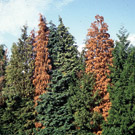 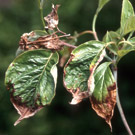 (Left) Port Orford Cedar with phytophthora
(Right) Dogwood with anthracnose 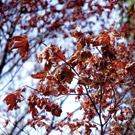 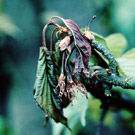
(Left) Maple with Verticillium wilt
(Right) Flowering Cherry with Brown Blossom Blight Help Plants Recover from Wet SpringOur wet spring has brought on a number of disease problems that manifest themselves in the summer. Diseases like: anthracnose on dogwoods, ash and sycamores; scab on fruiting and crab apples; blight on flowering cherries and photinia; Phytophthora root rot on cedars, dogwood, arborvitae and oak are rampant this year. Expect that your plants may look worse before they get better. With some diseases like Phytophthora or Verticillium they may never recover and simply die. Proper diagnosis is the first step, so call a Collier Arbor Care certified arborist to troubleshoot. As with many things in life, prevention is the key. Timely treatments, proper pruning and nutrition will all help to minimize problems and maintain plant health. What are the steps we can take to help our plants recover from disease?
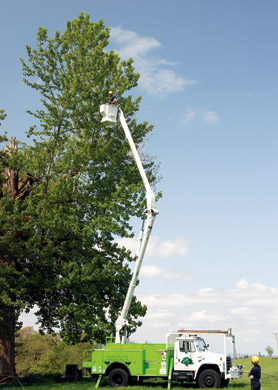
Due to the history of large branch failure the cuts were done from the safety of a bucket truck. Pro Bono Work Lengthens Life of Salem’s “Whip Tree”A two-man crew of Certified Arborists from Collier Arbor Care made sure that Silverton’s 154-year-old Riding Whip Tree will continue its long life as one of the State of Oregon’s 45 official Heritage trees. Currently owned by Jim Toeler at Geercrest farms, outside of Salem, the Black Cottonwood had been in poor health for some time before Collier’s two-person crew did the pro-bono thinning of the tree’s crown. There had been significant dieback in the crown and the tree had a history of large branch failure, so Collier’s arborists used the firm’s bucket truck to accomplish the large cuts needed in the crown. “We stayed out of that tree because of the history of large branch failure. There have been weddings under this tree and I told Jim to keep people away from it until we’d had a chance to work on it because it wasn’t safe. The cottonwood isn’t normally a long-lived tree. This one is old for a cottonwood and a good example of the potential danger to people from hazard trees,” said Collier Arbor Care President Terrill Collier, whose firm is among the oldest and largest in western Oregon. The 90-foot-tree, which has a trunk circumference of 18 feet, grew after 15-year-old Florinda Geer stuck her black cottonwood riding switch into the ground after returning from a horse ride in 1854. According to the Oregon Heritage Tree Program plaque at the tree, Florinda Geer married Timothy Davenport and in 1868 gave birth to Homer Davenport, a nationally famous political cartoonist, who spent many of his early years at the homestead. The Daughters of the American Revolution memorialized the tree in 1936 and it became Marion County’s first Heritage Tree in 1986. The Riding Whip Tree was dedicated as an Oregon Heritage Tree by the Heritage Tree Committee of the Oregon Travel Information Council in 2006. Collier has been active in local and state heritage tree programs and his firm has done pro-bono work on Lake Oswego’s Peg Tree and the 450-year-old Signature white oak at the Oregon Garden in Silverton. 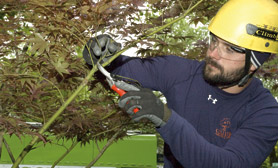 Certified Arborist, Brian French, specimen pruning a Japanese Maple
Certified Arborist, Brian French, specimen pruning a Japanese MapleSummer Pruning TipsOur rainy spring has slowed down the gardening, but has provided great growing conditions for luxuriant plant growth. Looking around the garden, however, we see that the jungle needs taming. Summer is the best time for pruning many of your fruit, flowering and ornamental trees and shrubs. The bloom is complete and the new growth elongated as spring ends and summer (finally!) starts. Flowering and ornamental trees and shrubs, such as rhododendrons, azaleas, dogwood, lilac, flowering cherry and plum, Japanese maple, small ornamental conifers, and hedges, just to name a few are best pruned after the spring flush of growth. Benefits of summer pruning include:
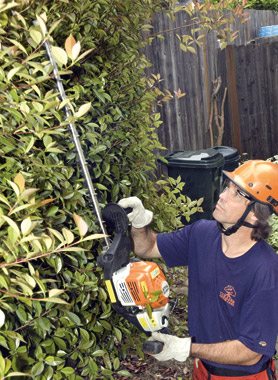 Certified Arborist, John Dale, shears a photinia hedge
Certified Arborist, John Dale, shears a photinia hedgeWhen summer pruning you should:
To find out how to manage your over grown plants give us a call. Our certified arborists have the expertise, skill, and proper equipment to efficiently prune your plants the safe and proper way. Your trees will love us! |
|
Home |
Services |
The Arbor Advisor |
Garden Calendar |
About Us |
Fact Sheets |
Contact Us |
Site Map Collier Arbor Care Portland 503-722-7267 Vancouver (360) 693-6056 Site contents and design ©2013 Collier Arbor Care |
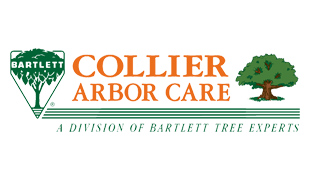






 top »
top »